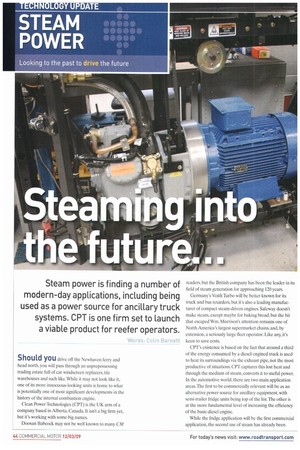Steam power is finding a number of modern-day applications, including
Page 44

Page 45

If you've noticed an error in this article please click here to report it so we can fix it.
being used as a power source for ancillary truck systems. CPT is one firm set to launch a viable product for reefer operators.
Words: Cohn Barnett
Should you drive off the Newhaven ferry and head north, you will pass through an unprepossessing trading estate full of car windscreen replacers, tile warehouses and such like. While it may not look like it, one of its more innocuous-looking units is home to what is potentially one of most significant developments in the history of the internal combustion engine.
Clean Power Technologies (CPT) is the UK arm of a company based in Alberta, Canada. It isn't a big firm yet, but it's working with some big names.
Doosan Babcock may not be well known to many CM readers, but the British company has been the leader in its field of steam generation for approaching 120 years.
Germany's Voith Turbo will be better known for its truck and bus retarders, but it's also a leading manufacturer of compact steam-driven engines. Safeway doesn't make steam, except maybe for baking bread, but the bit that escaped Wm. Morrison's attention remains one of North America's largest supermarket chains, and, by extension, a seriously large fleet operator. Like any, it's keen to save costs.
CPT's existence is based on the fact that around a third of the energy consumed by a diesel-cngined truck is used to heat its surroundings via the exhaust pipe, not the most productive of situations. CPT captures this lost heat and through the medium of steam, converts it to useful power. In the automotive world, there are two main application areas.The first to be commercially relevant will be as an alternative power source for ancillary equipment, with semi-trailer fridge units being top of the list. The other is at the more fundamental level of increasing the efficiency of the basic diesel engine.
While the fridge application will be the first commercial application, the second use of steam has already been tested, albeit in a rather specialised niche. It should be apparent that the hotter an engine's exhaust gas temperature, the more efficient it will be at generating steam. The twin-rotor Wankel rotary engine from the Mazda RX8 runs particularly hot, and one example fonnted the first working model of CPT's steam hybrid engine. One halt' of the twin-rotor engine functions normally, fuelled by petrol, but its exhaust output generates steam, which is then used to drive the second rotor.
Constructed to prove the concept, this side of the business is currently secondary to developing the revenue-earning fridge business, but it paves the way for a number of possibilities in a couple of years' time. For example, steam-generated power could be fed back into the host engine in a similar way to Scania's compoundturbo engine, and there could even be truck engines with some diesel-powered cylinders and some steam-powered in the same block.
Who are CPT?
The two key players in CPT are, in the best traditions, a commercial expert and an engineer. Canadian Abdul Mitha, a qualified barrister, founded the company and is the president and CEO. The engineer is Mike Burns, who has a background in automotive engineering with a host of global manufacturers. Most recently he has been employed within that centre of technical excellence along the Sussex coast, latterly as chief test engineer at the ill-fated Daewoo technical facility at Worthing. Much of CPT's work is based on early research by Professor Fred Bailey, founding Professor of Mechanical Engineering at the University of Sussex, who now occupies a place on CPT's Advisory Board.
Future plans
The Newhaven site houses offices and a prototype workshop complete with modern machine tools, an engine dynamometer and a newly installed truck-sized chassis dyno, all in one corner of an industrial unit. The remainder of the unit is currently in the throes of the existing tenant moving out and will become the production facility. If we had any doubts that the company was serious, they were dispelled by the sight of the same type of three-plane durability test rig that we recently saw on a visit to the Mercedes-Benz truck testing facilities in Germany.




















































































































































